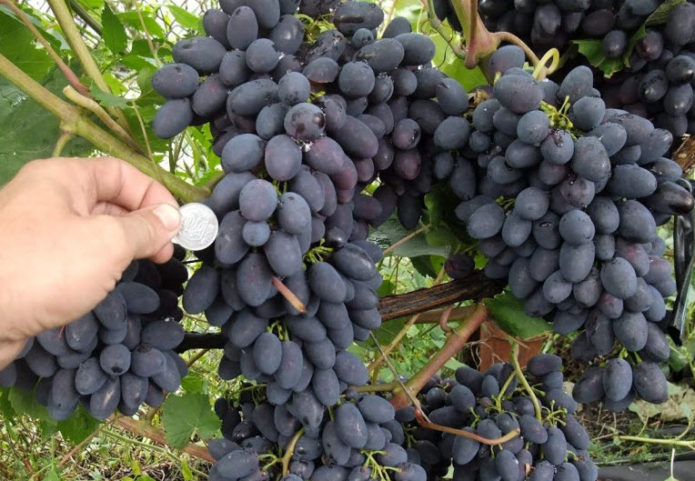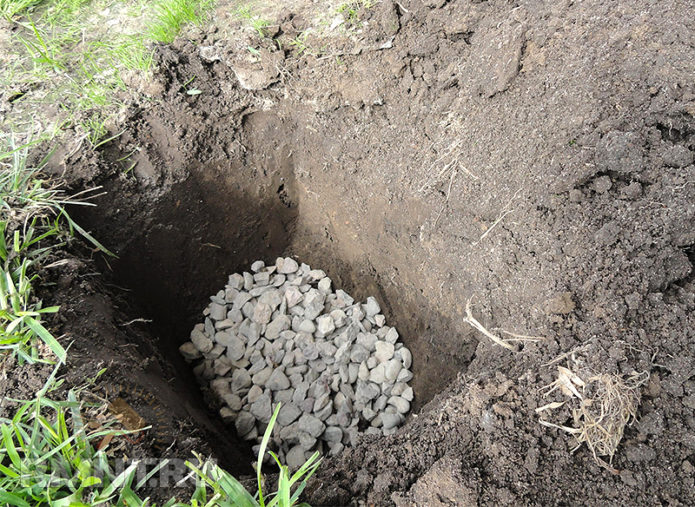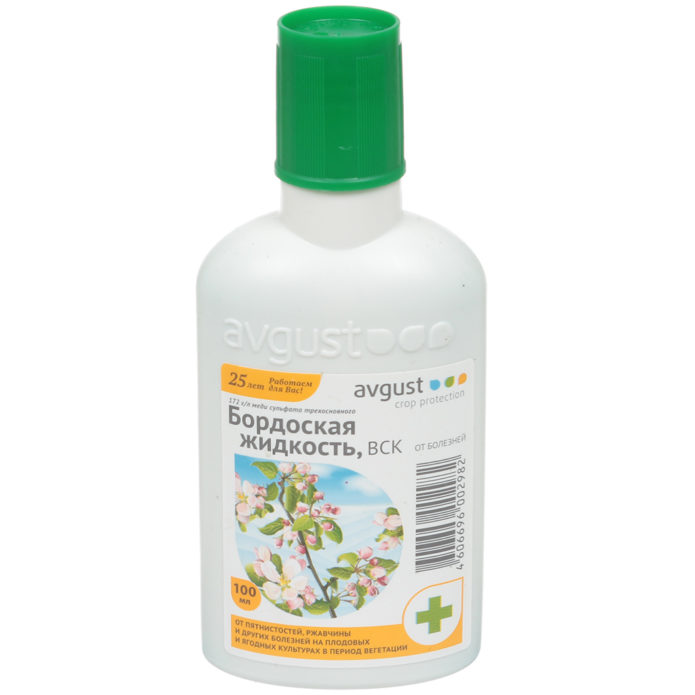Dark grape varieties are very popular with gardeners. Their berries are distinguished not only by their excellent appearance, but also by a high content of nutrients. One of the most widespread varieties of black-fruited grapes in Russia and the CIS countries is Codryanka, which is excellent both for industrial cultivation and for cultivation in small household plots.
Content
The history of growing grapes Codrianka
Codreanka was bred in 1985 by employees of the Moldavian Research Institute of Viticulture and Winemaking as a result of crossing Moldavia and Marshal varieties. She received her name in honor of a small village located not far from Chisinau. In Western Europe, this variety is distributed under the name Black magic (Black magic).
In 1997, Kodryanka was included in the Russian State Register of Breeding Achievements, as a variety recommended for cultivation in the North Caucasus, Lower Volga and Ural regions. On the territory of our country, it was organized by the All-Russian Research Institute of Viticulture and Winemaking named after Ya. Potapenko (city of Novocherkassk).
Description and characteristics of the variety
Codryanka is an early maturing table grape. Its berries are ready for harvesting within 117 days from the start of the growing season.
The first crop of Codreanca brings in the second or third year of cultivation.
Codryanka bushes are vigorous. Large black berries, covered with a clearly visible wax coating, are collected in conical clusters, the average weight of which is about 600 grams. With good care, it can grow up to 1.5 kg. With industrial cultivation, up to 78 quintals of high-quality grapes are obtained from one hectare of Codreanca, which is well tolerated for transportation.
The flesh of the berries is dense, crunchy, with a simple balanced taste and delicate aroma. The skin is thin and easily eaten. Fresh fruits contain from 8 to 19% of sugars with an acidity of 6-7 g / l. Tasting score - 8.2 points out of 10.
Codryanka berries are not only eaten fresh, but also used to prepare compote and wine vinegar. In addition, in Moldova, they make an excellent semi-dry table wine, which in its qualities is in no way inferior to drinks from technical grape varieties.
Codreanka easily tolerates temperatures as low as -23 ° C. It is tolerant to one of the main pests of grapes - phylloxera (grape aphid). In addition, it is rarely affected by mildew and gray mold.
Video: an overview of the Kodryanka variety
Features of planting and growing
Despite its unpretentiousness, Codryanka, like any other grape variety, needs to comply with the basic rules of agricultural technology.Performing them will not be difficult even for a novice winegrower.
Landing
Grapes are very fond of sun and warmth. Codreanka is no exception. It is better to plant it in well-lit and wind-protected places. A southeast slope or an area along the south side of a fence or building is ideal.
Kodryanka is not particularly demanding on the composition of the soil. She does not feel well only on very heavy or saline soils.
It is very important for the future good harvest and the correct choice of planting material. Most often, annual rooted cuttings are used in this capacity. A healthy seedling of this age should have one or two vines and a well-developed root system.
You can plant Kodryanka both in spring and autumn. But for the northern regions of our country, spring planting is preferable, which allows the young plant to take root before the onset of cold weather. It is usually produced in late April or early May, after the soil warms up to 15 ° C.
In the spring planting of grapes, a hole is dug and filled in September-October, in the autumn - a month before planting the grapes. At the bottom of the pit, a drainage layer of expanded clay, crushed stone or other similar material must be laid. The excavated earth is mixed with humus and sand in a ratio of 2: 1: 1. You can also add 1-2 tablespoons of complex fertilizer and a shovel of ash to the soil. The resulting mixture is filled into a pit and left until the grapes are planted.
During planting, a prepared Codryanka seedling is placed in a hole at an angle of 45 ° and carefully covered with fertile soil, observing the position of the root collar. It should rise 4–5 cm above the ground. Then the grapes are abundantly watered and mulched with humus, sawdust or previously cut grass.
Video: two ways to plant grapes
In the first year of cultivation, special attention is paid to regular watering of Codryanka, which is produced once every two weeks. Lack of moisture is very dangerous for a young plant with an insufficiently developed root system and can lead to its death.
Adult plant care
Despite its unpretentiousness, Codryanka needs the attention of the grower who grows it. In the absence of care, it is almost impossible to get a bountiful harvest. This is especially true for the northern regions, whose climatic conditions are poorly suited for growing grapes.
Watering
Grapes are a fairly drought-resistant plant. Codreanka is no exception. For growth and fruiting, two or three waterings per season are enough for her:
- during bud break;
- before flowering;
- during the setting of berries.
In hot and arid regions, in spring and autumn, abundant water-charging irrigation is carried out, maximizing the saturation of the earth with moisture.
Video: features of watering grapes
Pruning
Codryanka bushes, which are more than two to three years old, need formative pruning... The best time to carry it out is immediately after the end of the growing season. From 4 to 9 eyes are left on the vine, and no more than two on the replacement knot. The number of shoots is reduced to 17–20.
Also, during autumn pruning, unripe, dry and damaged shoots that cannot survive the winter are removed.
In the spring, the Codryanka vine is examined and all frost-damaged shoots are removed. After budding, it is also necessary to remove excess eyes that can cause excessive stress on the bush.
Video: spring formation of the Codryanka bush
Prevention of pea berries
The main disadvantage of the Kodryanka variety is its tendency to pea berries. Most often, it is caused by the following reasons:
- insufficient pollination;
- lack of nutrients;
- excessive load on the bush.
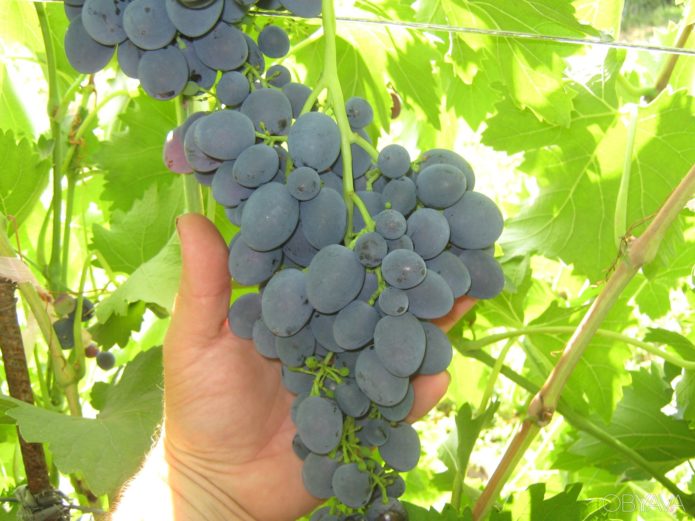
Irrigation is the appearance in a bunch of grapes of abnormally small berries that do not contain seeds, simultaneously with a small amount of normal
Significantly reduce the appearance of peas, and sometimes completely avoid it, a number of measures can be taken, including:
- attracting pollinating insects by planting melliferous plants (for example, mustard, rapeseed or phacelia) with grapes;
- artificial pollination of flowers in rainy weather;
- spraying flowers with water during a drought (high humidity prevents pollen from falling off the pistils);
- plant treatment with preparations containing large amounts of boron and zinc;
- crop normalization.
In large farms, the gibberellins are used to solve the problem of Codryanka peas. They contain phytohormones that stimulate the growth of fruits. In private vineyards, these drugs are rarely used.
Preparing for winter
In most of Russia, Kodryanka needs shelter for the winter. In regions with severe frosts, pre-dug trenches are often used, the bottom of which is lined with spruce branches. A vine tied in bunches is laid in them and fixed with wooden hooks or metal staples installed along the entire length of the trenches.
Top the grapes covered with a thick film. At the edges it is covered with earth in order to avoid damage to the integrity of the structure by strong wind. Some growers use wooden shields for additional insulation.
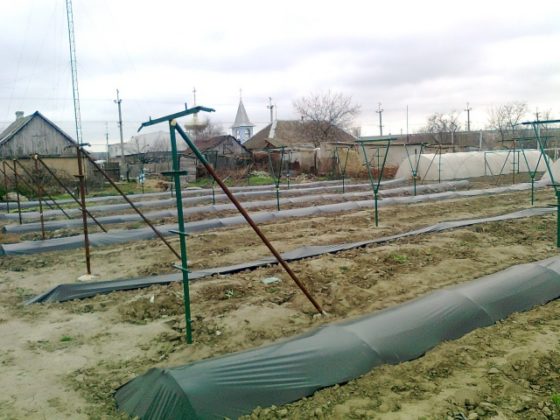
In order to avoid contact of the film with the vine, which promotes damping off, it is laid on metal arcs
They remove the shelter only after establishing a stable positive temperature. In order to avoid burns of the bark weaned from the bright sun, this procedure is best carried out in cloudy weather.
In regions where the temperature does not drop below 23 ° C, Codreanka may not be covered. For successful wintering of the plant, it is enough to mulch the near-trunk circle with humus or other organic matter. Mulch will protect the grape root system from frost and will be an excellent source of nutrients.
Disease and pest control
Winegrowers appreciate Codryanka for its increased resistance to fungal diseases. Preventive treatments with fungicidal preparations will help reduce the likelihood of their occurrence to zero. These include:
- bordeaux liquid;
- Topaz;
- Quadriz;
- Strobe;
- Ridomil Gold.
Preventive treatment is usually carried out three times per season: after removing the winter shelter, during the budding period and after flowering.
Wasps can cause significant damage to the crop. They love its sweet berries, the thin skin of which is easily nibbled by their strong jaws. To protect the grapes from the encroachment of these insects, small mesh bags that are worn on bunches will help. Placing baits with sweet syrup in the immediate vicinity of the bushes also has a good effect.
Advantages and disadvantages of Codryanka (table)
| Advantages | disadvantages |
| Excellent sweet and sour taste | Pea tendency |
| Large size of berries and brushes | Low winter hardiness |
| Above average resistance to mildew and gray mold | |
| Tolerance to phylloxera | |
| High yield | |
| Unpretentiousness |
Wine growers reviews about the variety
The first signal fruiting of my Codryanka was very spectacular. The first brushes were almost ready for our Kursk grape exhibition on July 24. Of course, the bottom of the tassels was still a little sour, but for our zone this is a very unusual and tasty grape. Sugar had gained 15 Br by that time. The rest were cut in mid-August, the berries are sweet and sour. The kids liked it. The weight of the brushes is around 1000-1850g.
Codryanka, along with Arcadia, is one of those early varieties on which it seems impossible to lose in the harvest. Despite the fact that every year you need to manicure peas (well, this is personal, IMHO) Codryanka is such a mammoth, which cannot be moved by new twins. This is the main variety on my vineyard for my husband.
Despite the peas, there is still nothing to replace Codryanka. Taste, stability - everything is at a high level.
I have been keeping codryanka since about 1988. I consider the variety with proper care very good and very productive. When new varieties appeared at one time I wanted to throw it away. But there is no replacement for it. But some, although they can argue with this. not the limit And taste is better than many new varieties. The flesh is crispy when fully ripe, the sweet skin is not felt when eating. Unlike many new hybrid forms.
My Codryanka is the third year. Last year there was a signaling. Somehow did not impress.
This year I left 8 bunches. One is about a kilogram. The rest 7 are all about 1500 kg. The bunches are very dense. There are few peas.
The taste is excellent, sweet, crispy berry.
Everyone liked it very much.
Despite its age, Codryanka remains one of the most popular grape varieties. It consistently pleases even inexperienced gardeners with large yields of large and tasty berries, and minor deficiencies of the variety are easily eliminated with good care.
